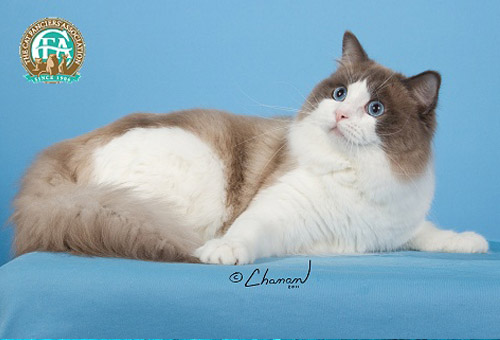

 |
GC, BW, RW SUPURRRAGS STRIPER OF LOTTARAGS, Seal Lynx Point & White Ragdoll Male Photo: © Chanan |
 Pictured: Second Best of Breed GC, RW LOTTARAGS HIT THE JACKPOT, Blue Point & White Ragdoll Male Photo: © Chanan There are four patterns: bi-color, van, mitted and colorpoint. Patterns come in six colors: seal, blue, chocolate, lilac, red, and cream. Points may be solid, lynx, tortie, or torbie (tortie and lynx). If you do the math, you can see that there are quite a large number of different combinations possible! CFA accepts bi-color and van patterns, mitted and colorpoints for showing in the full array of color combinations.
Colorpoint Ragdolls have the classic pointed markings with no white anywhere in their coat. Mitteds have white feet in the front and white boots that go all the way up and around the hock in the back, a white chin and belly stripe. Mitted Ragdolls may have a blaze, star or hourglass shaped atch of white on their forhead and nose. Bi- colors have more white¸ all four paws, their underbodies, chest, and an upside-down ‘V’ marking on their faces are white. They may have a splash or two of white on their backs. Only their tails, ears, and the outer part of their masks show the darker markings. In the Van pattern, only the top of the mask, ears, and tail, and perhaps a few spots on the body, show darker markings. Ragdolls were developed in the 1960’s by Ann Baker; a breeder in Riverside California. The origin of the Ragdoll breed consisted almost entirely of free-roaming cats. Ann bred Josephine, a domestic longhaired white female that was found running loose in her neighborhood, to other cats she owned or found. The offspring of this female had unique temperament traits that were very endearing. By selecting individuals with the look, temperament and criteria she wanted for her breeding program, she created the Ragdoll breed. Pricing on Ragdolls usually depends on type, applicable markings and bloodlines distinguished by Grand Champion (GC), National Regional winning parentage (NW or RW) or of Distinguished Merit parentage (DM). The DM title is achieved by the dam (mother) having produced five CFA grand champion/premier (alter) or DM offspring, or sire (father) having produced fifteen CFA grand champion/premier or DM offspring. Usually breeders make kittens available between twelve and sixteen weeks of age. After twelve weeks, kittens have had their basic inoculations and developed the physical and social stability needed for a new environment, showing, or being transported by air. Keeping such a rare treasure indoors, neutering or spaying and providing acceptable surfaces (e.g. scratching posts) for the natural behavior of scratching (CFA disapproves of declawing or tendonectomy surgery) are essential elements for maintaining a healthy, long and joyful life. There are CFA clubs devoted to the promotion, protection and preservation of the Ragdoll breed. For more information, please send inquiries to CFA at cfa@cfa.org. Text: Isabelle Bellavance & Mindy Ferreira Last Updated: Sunday, July 04, 2010
|
|||